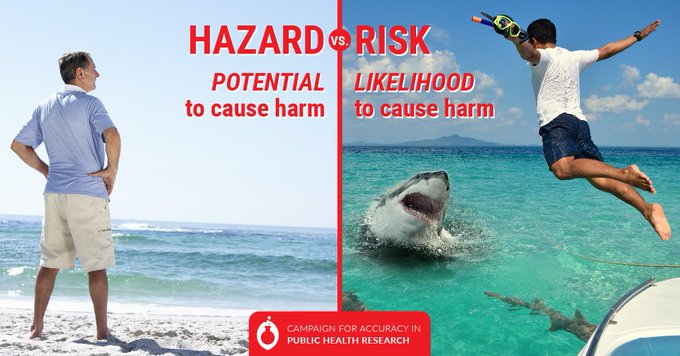Every day we are inundated
with various social media posts and news sources telling us about what does or
does not work, that some things may be harmful, or that a product is not safe
because it contains a chemical that causes cancer or other adverse health
effects in animals.
You may wonder if you should start avoiding certain products in hopes of
keeping you and your family safe.. It's confusing for other scientists as well,
and you may not be sure how or where to start when trying to make informed decisions, so here are a few tips that help me
sort it out:
1. Understand Exposure and Risk
We are exposed to numerous
activities each day that have the potential to be harmful. You may read
something suggesting that a chemical associated with cancer is also found in
consumer products, fruits, or beverages and wonder if it’s really causing you
harm. All things can be a hazard because hazard simply means the ability of
some thing or activity to cause harm. The real question is “What is my risk,
and what is the likelihood that I will be harmed by normal use or consumption
of this product?”
Risk is defined as the probability that harm will actually occur and that is
based on how you interact with a product or chemical or thing. While a lion
attack poses a high hazard of injury in the wild, if you live in Texas, where
the presence of encountering a lion is generally in a zoo, your risk of an
attack is low. It's the same with many chemicals. Chemistry is a basic
component of life, and we are naturally exposed to a broad range of chemicals
by nature and because our bodies produce chemicals through normal human
functions.
For example, formaldehyde is
produced by our bodies as part of the natural processes in our cells but it is
also an essential building block in the production of hundreds of items, like
automobile components, cabinetry, flooring and medical devices. How do some
reports link it to cancer when it is natural? They could, for example, be using
high doses in animals that are unlikely to be encountered by consumers or be using some form of statistical correlation. Recently, the U.S.
Environmental Protection Agency (EPA) initiated a risk evaluation of
formaldehyde with the purpose of determining whether formaldehyde presents real
risks to human health or the environment at realistic levels of exposure.
So should you be concerned?
EPA evaluates chemicals regularly, in case there might be new evidence, so that is not cause for worry. When it assesses possible adverse health effects, it will consider potential risk from formaldehyde exposure in the air, the normal levels of formaldehyde naturally found in the human body, and potential risk. It’s important to remember that risk depends on a variety of factors, including how much a person is exposed, how they are exposed, and for how long.

2. Rely on Scientific Experts and Data
Researchers have studied how formaldehyde enters into and moves throughout the body and multiple international and federal agencies have evaluated the science around formaldehyde to establish guidelines at safe levels. The World Health Organization developed indoor air quality guidelines that were conservative and protective. In the United States, formaldehyde is also regulated and EPA even established standards for formaldehyde that might come from composite wood products.
Additionally, federal agencies like the EPA, the Consumer Product Safety Commission and the Centers for Disease Control and Prevention employ a cadre of scientific experts in epidemiology, toxicology and exposure science. These scientists focus on evaluating information about chemicals and their findings and conclusions are made available on public websites. So when you see a story regarding a product or chemical, some important questions to ask are: what is the source of this information; is the information generated by a scientists with expertise in the field; and has the information been peer reviewed by other members of the scientific community.
3. Weigh the Science
When making a decision, big or small, it is important to evaluate all the information to make an informed decision. For example, when you are deciding on the best pizza restaurant to order takeout from, you "weigh" information you might know about quality of the food, cost, or past experiences. Similarly, when scientists see a claim about a chemical and its potential for harm, we weigh the quality of the data, specific strengths and weaknesses of the information, and any inconsistencies.
In the formaldehyde example, there are thousands of peer-reviewed scientific articles and dozens of chemical reviews already conducted by federal and international agencies spanning decades. To determine risk using so many studies, we conduct a systematic review because it uses a clearly defined approach to identify relevant scientific information, evaluates the quality of the data, and weighs the information to reach conclusions about human health risk.
A few questions to consider when we weigh the science, and you can also use when reading claims in media include “Is all the evidence reaching the same conclusions about the chemical or is this just one paper?” “Is the evidence discordant from what other studies have found?” “What does the scientific community or relevant regulatory agencies conclusions say?” and finally, “Is the data actually addressing the question I am trying to answer?”
There are also tools that can aid you in spotting “bad” science that include, for example, assessing if there are issues with the quality of the data or if the results have been misinterpreted.
The above tips highlight why science-based decision making to determine human health risks is so important. If hazard information is taken out of context and not appropriately used with an understanding of the available use and exposure information for a chemical, the conclusions can be mischaracterized and misunderstood. If you want a more detailed list, you can go to “A Rough Guide to Spotting Bad Science.”





Comments